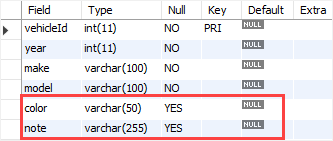Summary: in this tutorial, you will learn how to use the MySQL ALTER TABLE statement to add a column, alter a column, rename a column, drop a column, and rename a table.
Setting up a sample table
Let’s create a table named vehicles for the demonstration:
CREATE TABLE vehicles (
vehicleId INT,
year INT NOT NULL,
make VARCHAR(100) NOT NULL,
PRIMARY KEY(vehicleId)
);
Code language: SQL (Structured Query Language) (sql)
MySQL ALTER TABLE – Add columns to a table
The ALTER TABLE ADD statement allows you to add one or more columns to a table.
1) Add a column to a table
To add a column to a table, you use the ALTER TABLE ADD syntax:
ALTER TABLE table_name
ADD
new_column_name column_definition
[FIRST | AFTER column_name]
Code language: SQL (Structured Query Language) (sql)In this syntax:
table_name– specify the name of the table to which you want to add a new column or columns after theALTER TABLEkeywords.new_column_name– specify the name of the new column.column_definition– specify the datatype, maximum size, and column constraint of the new columnFIRST | AFTER column_namespecify the position of the new column in the table. You can add a column after an existing column (ATER column_name) or as the first column (FIRST). If you omit this clause, the column is appended at the end of the column list of the table.
The following example uses the ALTER TABLE ADD statement to add a column at the end of the vehicles table:
ALTER TABLE vehicles
ADD model VARCHAR(100) NOT NULL;
Code language: SQL (Structured Query Language) (sql)This statement shows the column list of the vehicles table:
DESCRIBE vehicles;
Code language: SQL (Structured Query Language) (sql)
As shown clearly from the output, the column model has been added to the vehicles table.
2) Add multiple columns to a table
To add multiple columns to a table, you use the following form of the ALTER TALE ADD statement:
ALTER TABLE table_name
ADD new_column_name column_definition
[FIRST | AFTER column_name],
ADD new_column_name column_definition
[FIRST | AFTER column_name],
...;
Code language: SQL (Structured Query Language) (sql)For example, this statement adds two columns color and note to the vehicles table:
ALTER TABLE vehicles
ADD color VARCHAR(50),
ADD note VARCHAR(255);
Code language: SQL (Structured Query Language) (sql)This statement shows the new structure of the vehicles table:
DESCRIBE vehicles;
Code language: SQL (Structured Query Language) (sql)MySQL ALTER TABLE – Modify columns
1) Modify a column
Here is the basic syntax for modifying a column in a table:
ALTER TABLE table_name
MODIFY column_name column_definition
[ FIRST | AFTER column_name];
Code language: SQL (Structured Query Language) (sql)It’s a good practice to view the attributes of a column before modifying it.
Suppose that you want to change the note column a NOT NULL column with a maximum of 100 characters.
First, show the column list of the vehicles table:
DESCRIBE vehicles;Code language: SQL (Structured Query Language) (sql)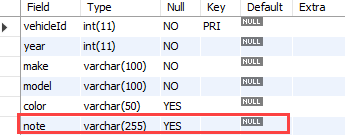
Then, modify the note column:
ALTER TABLE vehicles
MODIFY note VARCHAR(100) NOT NULL;Code language: SQL (Structured Query Language) (sql)Finally, show the column list of the vehicles table to verify the change:
DESCRIBE vehicles;Code language: SQL (Structured Query Language) (sql)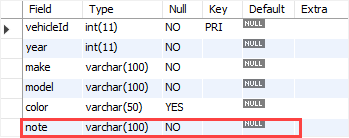
2) Modify multiple columns
The following statement allows you to modify multiple columns:
ALTER TABLE table_name
MODIFY column_name column_definition
[ FIRST | AFTER column_name],
MODIFY column_name column_definition
[ FIRST | AFTER column_name],
...;
Code language: SQL (Structured Query Language) (sql)First, show the current columns of the vehicles table:
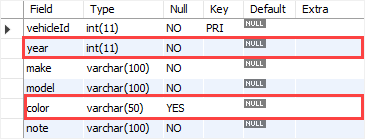
Second, use the ALTER TABLE MODIFY statement to modify multiple columns:
ALTER TABLE vehicles
MODIFY year SMALLINT NOT NULL,
MODIFY color VARCHAR(20) NULL AFTER make;
Code language: SQL (Structured Query Language) (sql)In this example:
- First, modify the data type of the
yearcolumn fromINTtoSMALLINT - Second, modify the
colorcolumn by setting themaximumlength to20, removing theNOT NULLconstraint, and changing its position to appear after themakecolumn.
Third, show the new column list of the vehicles table to verify the modifications:
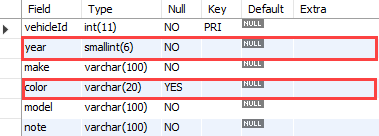
MySQL ALTER TABLE – Rename a column in a table
To rename a column, you use the following statement:
ALTER TABLE table_name
CHANGE COLUMN original_name new_name column_definition
[FIRST | AFTER column_name];
Code language: SQL (Structured Query Language) (sql)In this syntax:
- First, specify the name of the table to which the column belongs.
- Second, specify the column name and the new name followed by the column definition after the
CHANGE COLUMNkeywords. - Third, use the
FIRSTorAFTER column_nameoption to determine the new position of the column.
The following example uses the ALTER TABLE CHANGE COLUMN statement to rename the column note to vehicleCondition:
ALTER TABLE vehicles
CHANGE COLUMN note vehicleCondition VARCHAR(100) NOT NULL;Code language: SQL (Structured Query Language) (sql)Let’s review the column list of the vehicles table:
DESCRIBE vehicles;Code language: SQL (Structured Query Language) (sql)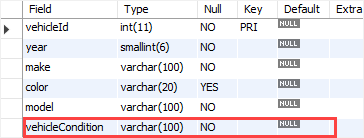
MySQL ALTER TABLE – Drop a column
To drop a column in a table, you use the ALTER TABLE DROP COLUMN statement:
ALTER TABLE table_name
DROP COLUMN column_name;
Code language: SQL (Structured Query Language) (sql)In this syntax:
- First, specify the name of the table that you want to drop a column after the
ALTER TABLEkeywords. - Second, specify the name of the column that you want to drop after the
DROP COLUMNkeywords.
This example shows how to remove the vehicleCondition column from the vehicles table:
ALTER TABLE vehicles
DROP COLUMN vehicleCondition;
Code language: SQL (Structured Query Language) (sql)MySQL ALTER TABLE – Rename table
To rename a table, you use the ALTER TABLE RENAME TO statement:
ALTER TABLE table_name
RENAME TO new_table_name;
Code language: SQL (Structured Query Language) (sql)In this syntax:
- First, specify the name of the table that you want to rename after the
ALTER TABLEkeywords. - Second, specify the new name for the table after the
RENAME TOkeywords.
This example renames the vehicles table to cars:
ALTER TABLE vehicles
RENAME TO cars; Code language: SQL (Structured Query Language) (sql)In this tutorial, you have learned how to use the MySQL ALTER TABLE statement to add a column, modify a column, rename a column, drop a column, and rename a table.
